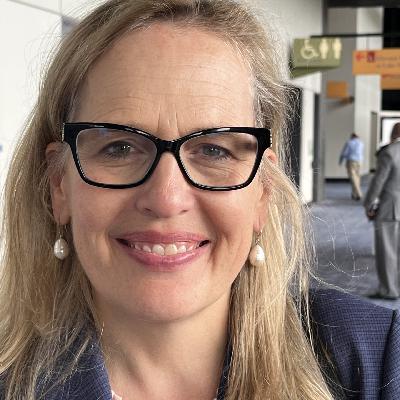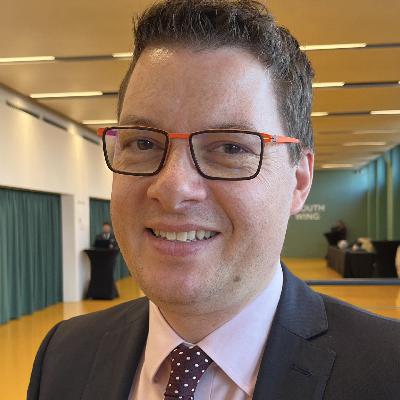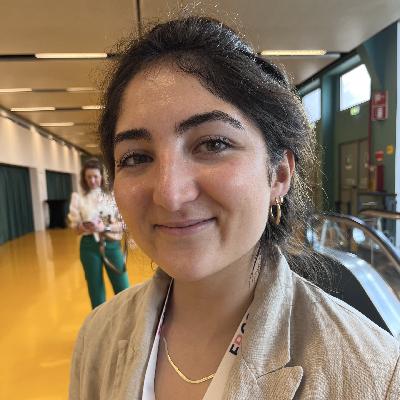Stefan Paepke MD: An End to “Jumping Breasts” with Mesh Supported Pre-Pectoral Breast Implants
Description
An interview with: Stefan Paepke MD, Interdisciplinary Breast Centre, Technical University of Munich, Germany, recorded at the 14th European Breast Cancer Conference, Milan, Italy.
MILAN, Italy—Women who need surgical implants after their mastectomy for breast cancer could now benefit from mesh-supported prosthetics that bring high rates of satisfaction and psychosocial well-being, with low complication rates. That’s according to findings from German PRO-Pocket-Trial, reported at the 14th European Breast Cancer Conference in Milan.
Study patients who had the new “tetanized” mesh-pocket-supported implants positioned by means of a “pre-pectoral” procedure found the technique prevented the unnatural breast mobility after reconstruction sometimes called: “jumping breasts”, while giving a better cosmetic appearance.
At the conference, our reporter Peter Goodwin talked with lead author of the study: Stefan Paepke MD, from the Interdisciplinary Breast Centre at the Technical University of Munich, in Germany
Stefan Paepke MD PODCAST
IN (Sarah MAXWELL): There’s good news for women ….OUT (Peter GOODWIN): European Breast Cancer Conference.I’m Peter Goodwin 10:48 secs
EBCC ABSTRACT:
“Mesh-Pocket Supported Prepectoral Direct-to-Implant Breast Reconstruction: Preliminary Results of a Prospective Analysis”
https://www.ejcancer.com/article/S0959-8049(22)01378-8/fulltext
Background:
Safety and breast aesthetics of direct-to-implant techniques are well recognized. Pre-pectoral techniques add a new dimension supported by the next generation of titanized mesh-pockets.
Material and Method:
A prospective international, multicentre observational investigation (PRO-Pocket-Trial CLINICALTRIALS.GOV NCT03868514 and DRKS00016673) is performed in 12 clinical centres in Germany and Austria to obtain data regarding patient reported outcome, cosmetic outcome and complications after TiLOOP® Bra Pocket supported prepectoral breast reconstruction up to the 24 months Follow-Up.
Results:
From 06/2019 until 02/2021, 313 patients with TiLOOP® Bra Pocket supported breast reconstructions were included. Age of the patients was between 23 and 80 years. The mean of the BMI was 24.5 ± 4.5 kg/m2. The most frequent indication for surgery was invasive ductal carcinoma followed by increased breast cancer risk. Unilateral surgery was performed in about 40%. The most frequent incision technique was an inframammary incision followed by inverted T-technique and hockey stick incision. About 70% of the breast implants were of anatomic shape; textured surface was also reported in about 75% of the reconstructions. None of the reported complications was unexpected; currently, 1 dysesthesia, 6 wound healing disturbances, 11 hematomas, 4 capsular fibrosis, 5 infections, 6 necrosis, and 15 seromas are documented.
Discussion:
Use of TiLOOP® Bra Pocket enables a new standard of prepectoral reconstructive techniques preserving the natural anatomy, thereby avoiding adverse effects associated with submuscular reconstruction, minimizing postoperative pain, risk of bleeding and the lack of animation deformity like “jumping breast phenomenon.” Pocket-supported reconstructive techniques become more valuable in times of changing to implants with smooth surface due to the excellent stabilization of implant position.
MORE:
Post Market Clinical Follow Up to “Patient Reported Outcome” Using a Titanised Polypropylene Mesh (TiLOOP® Bra Pocket) (PRO-Pocket)
Brief Summary:
“PRO-Pocket” – International prospective multicentre Post Market Clinical Follow Up to “Patient reported outcome” in primary or secondary breast reconstruction after mastectomy using a titanised polypropylene mesh (TiLOOP® Bra Pocket)
This international, multicentre, non-randomised, observational clinical device investigation will be performed to obtain post market information on TiLOOP® Bra Pocket surgical meshes for a period of up to two years. In particular, on patient reported satisfaction (BreastQTM), cosmetic outcome and the rate of complications.
The objective of the clinical Investigation is to establish the efficacy and safety of the TiLOOP® Bra Pocket.
The Investigation will be performed in ten clinical centres in Germany and Austria.
Observational
Actual Enrollment : 313 participants
Observational Model: Cohort
Time Perspective: Prospective
Official Title: “PRO-Pocket” – International Prospective Multicenter Post Market Clinical Follow Up to “Patient Reported Outcome” in Primary or Secondary Breast Reconstruction After Mastectomy Using a Titanised Polypropylene Mesh (TiLOOP® Bra Pocket)
Actual Study Start Date : July 4, 2019
Actual Primary Completion Date : June 22, 2022
Actual Study Completion Date : November 15, 2023
Primary or secondary breast reconstruction following mastectomy with titanised polypropylene mesh TiLOOP® Bra Pocket
Primary Outcome Measures :
Quality of Life – Patient reported outcome [ Time Frame: 12 months after study treatment ]
The primary endpoint is defined as the change of the four BreastQ domain scores before study treatment compared to twelve months after study treatment. The BreastQ questionnaire yields a domain score in the range from zero to 100. Wheras a score of 100 is the best score. The study hypothesis is that the patient’s QoL after the study intervention treatment is not worse than the QoL prior to the intervention study
Ages Eligible for Study: 18 Years and older (Adult, Older Adult)
Sexes Eligible for Study: Female
Accepts Healthy Volunteers: Yes
Sampling Method: Non-Probability Sample
Study Population
Women with indicated implant based breast reconstruction after mastectomy.
Criteria
Inclusion Criteria:
Age [≥ 18]
Indications of breast reconstruction: histologically confirmed breast cancer, precancerous lesions (DCIS, LCIS), mutation carrier with increased breast cancer risk, strong family history (lifetime risk > 15%)
The patient is capable to realise the nature, aims and possible consequences of the clinical trial (MPG §20.2.1)
Patient information has been provided and all written consents of the patient are available
Exclusion Criteria:
Metastatic breast cancer
Patient with known contraindications against mesh-assisted or plastic-reconstructive breast surgery according to the instruction for use
Patient is kept in an institution under judicial or official orders (MPG §20.3)
Participate in another operative clinical trial, if it relates to the area of reconstructive breast surgery and/or influences the primary endpoint of the clinical trial
Contacts and Locations
Go to sections
Information from the National Library of Medicine
To learn more about this study, you or your doctor may contact the study research staff using the contact information provided by the sponsor.
Please refer to this study by its ClinicalTrials.gov identifier (NCT number): NCT03868514
Locations
Austria
Universitätsklinik für Frauenheilkunde, Allgemeines Krankenhaus der Stadt Wien
Vienna, Austria, 1090
Germany
Vivantes Klinikum Am Urban
Berlin, Germany, 10967
DRK Kliniken Westend
Berlin, Germany, 14050
Universitätsklinikum Bonn
Bonn, Germany, 53127
Kliniken Essen Mitte; Evang. Huyssens-Stiftung
Essen, Germany, 45136
Agaplesion Markus Krankenhaus
Frankfurt, Germany, 60431
Universitätsmedizin Greifswald
Greifswald, Germany, 17475
Universitätsklinikum Heidelberg
Heidelberg, Germany, 69120
Rotkreuzklinikum München
Munich, Germany, 80637
Klinikum rechts der Isar der Technischen Universität München
Munich, Germany, 81675
Universitätsklinikum Ulm
Ulm, Germany, 89075
GRN Klinik Weinheim
Weinheim, Germany
treatment . The following four domains are relavant: Satisfaction with breasts, Psychosocial well-being, Physical well-being:chest and Sexual well-being.
Secondary Outcome Measures :
Quality of Life – Patient reported outcome [ Time Frame: 6 and 24 months after study treatment ]
The change of the four BreastQ domain scores before study treatment compared to six months and 24 months after study treamtment.
Complication rate [ Time Frame: 6, 12 and 24 months after study treatment ]
The number and rate of occurrence of adverse events is reported as a secondary endpoint along with a tabulation of the types of adverse events (6, 12 and 24 months after study treatment).
Cosmetic outcome [ Time Frame: 6, 12 and 24 months after study treatment ]
The cosmetic outcome is assessed based on photographs 6, 12 and 24 months after study treatment by descriptive statistics (an independent expert, the physician in charge and the patient assess the cosmetic outcome).
























